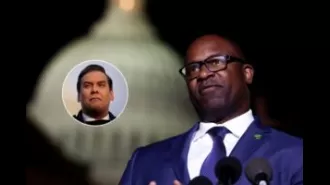Politicians claiming to call for a ceasefire may not actually be doing so.
Lawmakers are calling for a "ceasefire" in Gaza, but attaching conditions that make it impossible to actually achieve.
November 29th 2023.

The list of members of Congress calling for a ceasefire in Gaza has grown to about four dozen, with several members joining the chorus over the last week, amid a temporary truce between Israel and Hamas and sustained protests across the United States. Yet as the word “ceasefire” gains currency, a closer look at some lawmakers’ statements raises questions about whether they are truly pushing for an end to the violence.
Some members of Congress are coupling their calls for a ceasefire with conditions like the removal of Hamas, which is ostensibly Israel’s justification for its brutal campaign against Gaza, while others are using the word in vague statements that leave room for interpretation.
“Calls from members of Congress that demand regime change before there is an end to Israel’s bombardment are calls to extend and prolong a situation in which Israel is killing Palestinian children every single hour,” said Beth Miller of Jewish Voice for Peace Action, an organization that has co-led massive pro-peace demonstrations across the country.
The push for a ceasefire began about a week into Israel’s assault on Gaza, when Rep. Cori Bush, D-Mo., led a 13-member resolution for an “immediate deescalation and cease-fire in Israel and occupied Palestine.” As people across the country have inundated their representatives with demands for a ceasefire — Yasmine Taeb, political director for Muslim-led justice group MPower Change Action Fund, said an effort by her organization and the Adalah Justice Project has generated more than 429,000 letters to the House — the number has slowly climbed to 49 across both chambers of Congress.
A poll from left-leaning outfit Data for Progress in October found 66 percent of voters in favor of a ceasefire. A Reuters poll conducted nearly a month later found 68 percent of respondents in favor of one, while a YouGov poll released days later found only 20 percent of respondents opposed to a ceasefire.
On Monday, four days into the ongoing humanitarian pause, Israeli Defense Minister Yoav Gallant told Israel Defense Force soldiers that when Israel re-ups the fighting, its “strength will be greater, and it will take place throughout the entire Strip. … We will use the same amount of power and more.”
The pledge comes while the World Health Organization warns that more Palestinians may die from disease than the 15,000 who have already been killed by Israel’s bombardment campaign since October 7 — and that’s if conditions remain as they are, not if they worsen.
There’s no way the conflict ends other than a permanent ceasefire, said Yousef Munayyer, a political analyst and senior fellow at the Arab Center Washington DC. “How much do you actually need to see before you decide to see enough?”
As most of Congress remains mum on stopping the violence — with no Republican calling for a definitive end to the hostilities and beginning of a peace process — some members are invoking the word “ceasefire” but are hedging.
On November 19, as the Gaza death toll eclipsed 11,000, California Democratic Reps. Judy Chu and Jared Huffman both called for a ceasefire. Like other members of Congress, they conditioned their demand on Hamas’s release of every hostage, but they placed a new demand as well: that Hamas be removed from power.
Rep. Dan Goldman, D-N.Y., who has faced ongoing protests from Jewish peace groups and their allies, took to Twitter on Monday to thank Joe Biden for securing a pause in the fighting. He went on to invoke a “mutual and unconditional ceasefire” dating back to May 2021 that he said Hamas violated on October 7. Unless a call for a ceasefire includes the removal of Hamas, Goldman wrote, the U.S. “must continue to support Israel’s just and legitimate defense of its borders and its people.”
“What it amounts to is a way for members to kind of hide in a safe spot or safer spot to not really take a position.”
This requirement mirrors Israel’s justification for the violence: to weed out Hamas. Even for those who do see that as a necessary pathway to peace, Munayyer argued, it couldn’t be accomplished without a permanent ceasefire. “How does that happen? You know, it doesn’t happen unless you have a ceasefire,” he said. “What it amounts to is a way for members to kind of hide in a safe spot or safer spot to not really take a position.”
For Munayyer, the reluctance and ambivalence around the word “ceasefire” in Congress is about politics, not policy. “We’re talking about thousands of people dying and you’re wordsmithing ‘ceasefire,’” he said. “The interests that are shaping those decisions are wildly different than the stakes that actually matter here. And it’s quite stunning.”
Children collect any available wood to burn in the absence of gas as Palestinians continue to live under difficult conditions amid humanitarian pause in Khan Yunis, Gaza on November 29, 2023.
Photo: Abed Zagout/Anadolu via Getty Images
Rep. Teresa Leger Fernández, D-N.M., for her part, expressed support for the Biden administration’s work toward the temporary ceasefire and added that she supports “such a ceasefire and additional actions to release all the hostages, address the humanitarian crisis, and protect all civilians from violence — Palestinian and Israeli,” but did not call for a total end to the war. The push for a ceasefire in Gaza has seen a massive surge in support from members of Congress in the past week, as the temporary truce between Israel and Hamas and protests across the United States draw attention to the conflict. However, a closer look at what some lawmakers are saying raises questions about whether their statements are truly pushing for an end to the violence.
Beth Miller of Jewish Voice for Peace Action, an organization pushing for peace, says that lawmakers who demand regime change before there is an end to Israel's bombardment, are in fact prolonging a situation in which Palestinian children are dying every hour. This push for a ceasefire started a week into Israel's assault, when Rep. Cori Bush, D-Mo., led a resolution for an “immediate deescalation and cease-fire in Israel and occupied Palestine.” This has led to 429,000 letters being sent to the House from organizations like MPower Change Action Fund and the Adalah Justice Project.
A recent Data for Progress poll in October found 66 percent of voters in favor of a ceasefire, while a Reuters poll conducted nearly a month later found 68 percent of respondents in favor of one. However, Israeli Defense Minister Yoav Gallant told Israeli Defense Force soldiers on Monday that when Israel re-ups the fighting, it will use more power and will take place throughout the entire Strip.
Yousef Munayyer, a political analyst and senior fellow at the Arab Center Washington DC, says that there is no way the conflict ends other than with a permanent ceasefire. However, many members of Congress are still not calling for a definitive end to the hostilities and instead are using the word "ceasefire" in vague statements that leave room for interpretation. California Democratic Reps. Judy Chu and Jared Huffman called for a ceasefire, but conditioned it on Hamas' removal from power.
Rep. Dan Goldman, D-N.Y., took to Twitter to thank Joe Biden for securing a pause in the fighting and invoked a “mutual and unconditional ceasefire” dating back to May 2021. He said that unless a call for a ceasefire includes the removal of Hamas, the U.S. must support Israel's defense of its borders and people.
Munayyer argues that the reluctance and ambivalence around the word “ceasefire” in Congress is more about politics than policy. He says that the interests that are shaping these decisions are different than the stakes that actually matter and that wordsmithing "ceasefire" in this situation is quite stunning. As Palestinians continue to suffer under difficult conditions, it is clear that a permanent ceasefire is the only way to end the conflict.
Some members of Congress are coupling their calls for a ceasefire with conditions like the removal of Hamas, which is ostensibly Israel’s justification for its brutal campaign against Gaza, while others are using the word in vague statements that leave room for interpretation.
“Calls from members of Congress that demand regime change before there is an end to Israel’s bombardment are calls to extend and prolong a situation in which Israel is killing Palestinian children every single hour,” said Beth Miller of Jewish Voice for Peace Action, an organization that has co-led massive pro-peace demonstrations across the country.
The push for a ceasefire began about a week into Israel’s assault on Gaza, when Rep. Cori Bush, D-Mo., led a 13-member resolution for an “immediate deescalation and cease-fire in Israel and occupied Palestine.” As people across the country have inundated their representatives with demands for a ceasefire — Yasmine Taeb, political director for Muslim-led justice group MPower Change Action Fund, said an effort by her organization and the Adalah Justice Project has generated more than 429,000 letters to the House — the number has slowly climbed to 49 across both chambers of Congress.
A poll from left-leaning outfit Data for Progress in October found 66 percent of voters in favor of a ceasefire. A Reuters poll conducted nearly a month later found 68 percent of respondents in favor of one, while a YouGov poll released days later found only 20 percent of respondents opposed to a ceasefire.
On Monday, four days into the ongoing humanitarian pause, Israeli Defense Minister Yoav Gallant told Israel Defense Force soldiers that when Israel re-ups the fighting, its “strength will be greater, and it will take place throughout the entire Strip. … We will use the same amount of power and more.”
The pledge comes while the World Health Organization warns that more Palestinians may die from disease than the 15,000 who have already been killed by Israel’s bombardment campaign since October 7 — and that’s if conditions remain as they are, not if they worsen.
There’s no way the conflict ends other than a permanent ceasefire, said Yousef Munayyer, a political analyst and senior fellow at the Arab Center Washington DC. “How much do you actually need to see before you decide to see enough?”
As most of Congress remains mum on stopping the violence — with no Republican calling for a definitive end to the hostilities and beginning of a peace process — some members are invoking the word “ceasefire” but are hedging.
On November 19, as the Gaza death toll eclipsed 11,000, California Democratic Reps. Judy Chu and Jared Huffman both called for a ceasefire. Like other members of Congress, they conditioned their demand on Hamas’s release of every hostage, but they placed a new demand as well: that Hamas be removed from power.
Rep. Dan Goldman, D-N.Y., who has faced ongoing protests from Jewish peace groups and their allies, took to Twitter on Monday to thank Joe Biden for securing a pause in the fighting. He went on to invoke a “mutual and unconditional ceasefire” dating back to May 2021 that he said Hamas violated on October 7. Unless a call for a ceasefire includes the removal of Hamas, Goldman wrote, the U.S. “must continue to support Israel’s just and legitimate defense of its borders and its people.”
“What it amounts to is a way for members to kind of hide in a safe spot or safer spot to not really take a position.”
This requirement mirrors Israel’s justification for the violence: to weed out Hamas. Even for those who do see that as a necessary pathway to peace, Munayyer argued, it couldn’t be accomplished without a permanent ceasefire. “How does that happen? You know, it doesn’t happen unless you have a ceasefire,” he said. “What it amounts to is a way for members to kind of hide in a safe spot or safer spot to not really take a position.”
For Munayyer, the reluctance and ambivalence around the word “ceasefire” in Congress is about politics, not policy. “We’re talking about thousands of people dying and you’re wordsmithing ‘ceasefire,’” he said. “The interests that are shaping those decisions are wildly different than the stakes that actually matter here. And it’s quite stunning.”
Children collect any available wood to burn in the absence of gas as Palestinians continue to live under difficult conditions amid humanitarian pause in Khan Yunis, Gaza on November 29, 2023.
Photo: Abed Zagout/Anadolu via Getty Images
Rep. Teresa Leger Fernández, D-N.M., for her part, expressed support for the Biden administration’s work toward the temporary ceasefire and added that she supports “such a ceasefire and additional actions to release all the hostages, address the humanitarian crisis, and protect all civilians from violence — Palestinian and Israeli,” but did not call for a total end to the war. The push for a ceasefire in Gaza has seen a massive surge in support from members of Congress in the past week, as the temporary truce between Israel and Hamas and protests across the United States draw attention to the conflict. However, a closer look at what some lawmakers are saying raises questions about whether their statements are truly pushing for an end to the violence.
Beth Miller of Jewish Voice for Peace Action, an organization pushing for peace, says that lawmakers who demand regime change before there is an end to Israel's bombardment, are in fact prolonging a situation in which Palestinian children are dying every hour. This push for a ceasefire started a week into Israel's assault, when Rep. Cori Bush, D-Mo., led a resolution for an “immediate deescalation and cease-fire in Israel and occupied Palestine.” This has led to 429,000 letters being sent to the House from organizations like MPower Change Action Fund and the Adalah Justice Project.
A recent Data for Progress poll in October found 66 percent of voters in favor of a ceasefire, while a Reuters poll conducted nearly a month later found 68 percent of respondents in favor of one. However, Israeli Defense Minister Yoav Gallant told Israeli Defense Force soldiers on Monday that when Israel re-ups the fighting, it will use more power and will take place throughout the entire Strip.
Yousef Munayyer, a political analyst and senior fellow at the Arab Center Washington DC, says that there is no way the conflict ends other than with a permanent ceasefire. However, many members of Congress are still not calling for a definitive end to the hostilities and instead are using the word "ceasefire" in vague statements that leave room for interpretation. California Democratic Reps. Judy Chu and Jared Huffman called for a ceasefire, but conditioned it on Hamas' removal from power.
Rep. Dan Goldman, D-N.Y., took to Twitter to thank Joe Biden for securing a pause in the fighting and invoked a “mutual and unconditional ceasefire” dating back to May 2021. He said that unless a call for a ceasefire includes the removal of Hamas, the U.S. must support Israel's defense of its borders and people.
Munayyer argues that the reluctance and ambivalence around the word “ceasefire” in Congress is more about politics than policy. He says that the interests that are shaping these decisions are different than the stakes that actually matter and that wordsmithing "ceasefire" in this situation is quite stunning. As Palestinians continue to suffer under difficult conditions, it is clear that a permanent ceasefire is the only way to end the conflict.
[This article has been trending online recently and has been generated with AI. Your feed is customized.]
[Generative AI is experimental.]
0
0
Submit Comment





